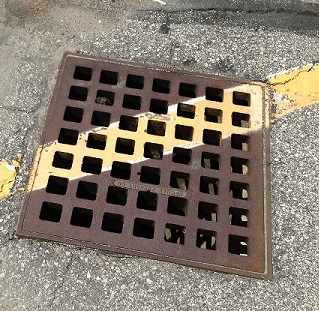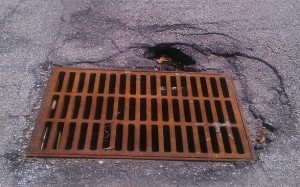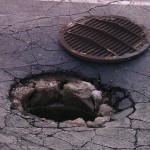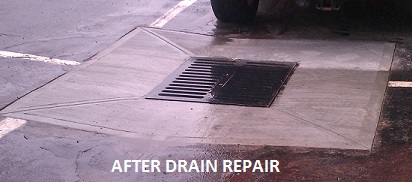The storm drain plays an important role in the preservation of a parking lot. In order for a parking lot to maintain its integrity the subsurface needs to remain dry, which means water needs to be channeled off the parking lot via storm drains.
Drains can be as little as one foot deep to six feet deep or deeper. The drain is comprised of grate, frame, catch basin and pipes. All of these components must be connected and tightly sealed.
The top of the drain is a metal grate and a frame that the grate sits in. The frame is placed prior to asphalt being poured and rests on the catch basin. (In some cases the frame will be encased in a concrete collar.) The catch basin typically has a pipe in the bottom which delivers the water to a culvert or nearby waterway.
Gaps or leaks in the system can result in a wet sub base, which in turn can create a soft foundation for the asphalt. The relatively hard asphalt will break if not supported properly by a sub base, resulting in cracked asphalt (alligator areas), pot holes, sunken areas or holes in the asphalt.
When the drain structure becomes compromised and allows water to access the sub base damage can occur. With heavy rains, where the drain can reach its capacity to funnel off water, the pressure can be great enough to wash out the sub base material and create a void under the asphalt. While everything looks fine from the surface a hole is lurking below. The next car that runs over the asphalt with a void underneath will break the asphalt exposing the hole. Now the water has a new path off the lot and the hole can get much larger and in most cases, cause further damage to the foundation of the drain.
So how do you check the condition of the drain? Well, it’s kind of like going to the dentist. You have to open your mouth for the dentist to see inside. The drain grate is the mouth of the drain. So, first the drain grate needs to be removed for proper inspection.
WARNING: Storm drain grates can weigh about 100-150 pounds, on average. Storm drain grates prevent large objects from getting into the drainage system and plugging it up. Drains grate removal is not for the average person. A pry bar, strong legs and back are needed to remove the grate.
Once the grate is removed, visually inspect the area around the top of the drain and work down to the bottom. Look for gaps, voids, loose bricks or block. A depression in the asphalt next to the drain can be an indication there is a potential problem.
Some drains are located in the middle of the parking lot and are connected to other drains via underground pipes. These pipes can separate and cause the sub base material to wash out. This can create what is known as a sink hole. To repair a sink hole it requires the asphalt to be cut and the sub base excavated to the depth of the pipe. The pipe can then be patched or repaired and encased in concrete. Asphalt will be used to patch the surface area to maintain a consistent surface material.
Storm drains are a very important part of a parking lot’s infrastructure, but are often forgotten when it comes to repairs. The next time you walk through your parking lot, take a look at the drains. If you don’t feel confident in determining whether the storm drains are in need of repairs, don’t hesitate to call Otto’s Parking Marking. Our knowledgeable sales staff will access the storm drains and let you know their condition and what, if any, repairs should be done.




